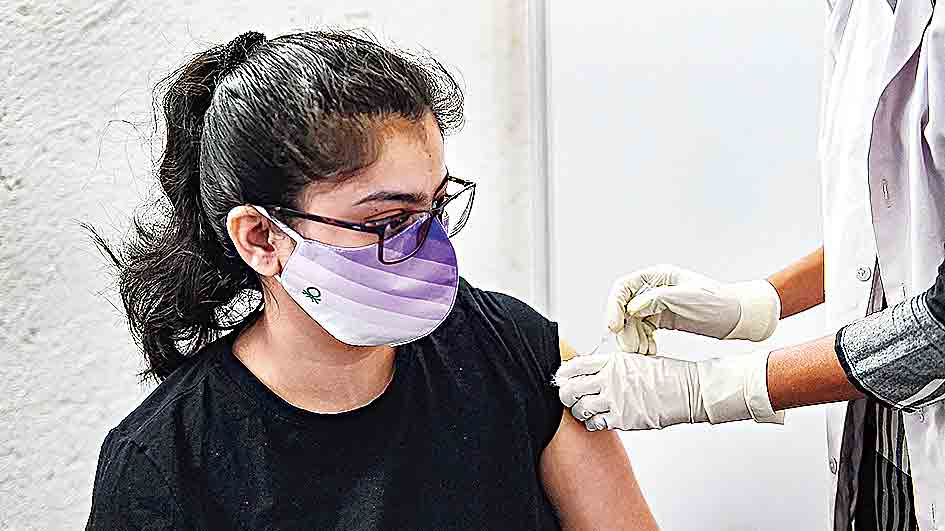Health officials on Friday underlined the need for public health measures and personal precautions to contain any fresh Covid-19 surges amid India’s rising omicron counts, signs of growing epidemics in several cities including Calcutta, and large waves in Europe.
The officials called on district health authorities to impose restrictions on public movements if local test positivity rates rose beyond 5 per cent and urged the public to avoid non-essential travel and mass gatherings and observe festivities only in “low intensity”.
Their calls come weeks ahead of the planned February-March Assembly elections in five states — Uttar Pradesh, Punjab, Uttarakhand, Goa and Manipur.
India’s count of omicron infections increased from 77 on Thursday to 101 on Friday. These included 32 in Maharashtra, 22 in Delhi, 17 in Rajasthan, 8 each in Karnataka and Telangana, 5 each in Gujarat and Kerala, and 1 each in Andhra Pradesh, Bengal, Chandigarh and Tamil Nadu.
The country’s Covid-19 epidemic has been stable with the nationwide daily average of new infections staying below 10,000 for three weeks and an encouraging test positivity rate below 1 per cent for four weeks. Officials have, however, cautioned against laxity in personal precautions or public health measures.
“We’re in an unexpected scenario…. A new phase of the pandemic is being experienced in Europe,” said Vinod Paul, member (health) in Niti Aayog, the Centre's apex think tank, referring to the current surges in the UK and France where daily new infections have either surpassed or are approaching the peaks of earlier waves despite high vaccination coverage.
In South Africa, too, the current omicron-fuelled wave is causing more daily infections than during any of the country’s three earlier Covid-19 waves.
The UK’s current seven-day average of daily new infections is over 60,000 which, Paul said, if applied to India’s population would be equivalent to over 1.2 million daily fresh cases, or thrice the 400,000 infections during the peak of India’s second wave in early May.
“This kind of spread should not happen. Conversely, we need to be prepared to effectively face such scenarios too… profound caution is required,” Paul said, underlining the need for intensive testing, contact tracing and efforts to contain clusters wherever they emerge.
Paul, chair of the national Covid-19 task force, himself had said in early October that India’s Covid-19 “preparedness is pitched for a surge of 450,000 to 500,000 daily cases”.
With that level of preparedness, experts say, India will be unable to cope with 1.2 million daily infections. “If the government fears India might have over 1.2 million cases a day, what is it doing about that concern? It should have sleepless nights now,” said a senior virologist.
However, the virologist, who requested not to be named, also said that applying the UK’s current daily infection counts on India’s population is “simplistic” because epidemic patterns can’t be so easily extrapolated from one country to another.
Multiple factors such as the age distribution of the population, vaccination rates and prior Covid-19 infections would influence the counts of new infections, even those driven by omicron, the virologist said.
Nineteen districts — including nine in Kerala, five in Mizoram, one each in Nagaland, Rajasthan, Sikkim and Arunachal Pradesh, and Calcutta — have test positivity rates between 5 and 10 per cent. The test positivity rate, the proportion of tests positive among samples tested, needs to be as low as possible, ideally 5 per cent or lower.
A high test positivity rate implies a large epidemic or inadequate testing. Four districts in Mizoram — Champal, Khawzawl, Mamit and Serchhip — and Namsal in Arunachal Pradesh have positivity rates above 10 per cent.
“These 24 districts where test positivity rates are greater than 5 per cent need to ensure local restrictive measures until test positivity rates fall below 5 per cent for at least two weeks,” said Balram Bhargava, director-general of the Indian Council of Medical Research.
Bhargava, in a message for the general public, also said it was now “time to avoid non-essential travel, time to avoid mass gatherings, and time to observe low-intensity festivities — ushering the New Year has to be in low intensity”.
The rate of decline of India’s epidemic has remained fairly stable for nearly two months, but new infection counts have grown over the past week to two weeks in Calcutta, Chennai, Delhi, Mumbai and Pune.
The R values — a measure of the number of people infected by one infected person — in all five cities are greater than 1, implying the number of people getting infected is increasing.
Researchers at the Institute of Mathematical Sciences, Chennai, have estimated Calcutta’s R value to be 1.05 between December 6 and 14, while Delhi’s R value was 1.12 between December 11 and 15. If R is 1.05, 100 infected people would give rise to 105 new cases.
“Urban India is definitely showing a rise in cases while the rest of India appears stable,” said Sitabhra Sinha, a scientist at the IMSc, Chennai, whose team has been tracking the epidemic’s course since early 2020.
“Given that R values can change very rapidly at the scale of cities, it is of course possible that the situation may improve abruptly or not in the coming week,” Sinha said.
Health experts say India’s omicron counts are too small for now to draw any epidemiological inferences on how widespread the infection is or what impact it might have on the country’s epidemic.
Samiran Panda, chief of non-communicable diseases at the ICMR, said all that could be said from the small number of omicron cases was that some had a history of travel and some had a history of contact with confirmed cases, while and no plausible exposure could be identified for some.
“This is consistent with the observed transmission dynamics in South Africa and other countries --- that asymptomatic, unsuspected cases of omicron have the potential to spread the infection to others,” Panda said.











